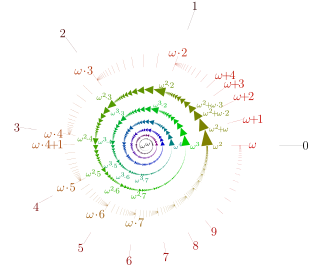In mathematics, specifically set theory, the continuum hypothesis is a hypothesis about the possible sizes of infinite sets. It states:
There is no set whose cardinality is strictly between that of the integers and the real numbers.

In mathematics, a cardinal number, or cardinal for short, is what is commonly called the number of elements of a set. In the case of a finite set, its cardinal number, or cardinality is therefore a natural number. For dealing with the case of infinite sets, the infinite cardinal numbers have been introduced, which are often denoted with the Hebrew letter (aleph) marked with subscript indicating their rank among the infinite cardinals.
In mathematics, especially in order theory, the cofinality cf(A) of a partially ordered set A is the least of the cardinalities of the cofinal subsets of A.
In the mathematical discipline of set theory, 0# is the set of true formulae about indiscernibles and order-indiscernibles in the Gödel constructible universe. It is often encoded as a subset of the natural numbers, or as a subset of the hereditarily finite sets, or as a real number. Its existence is unprovable in ZFC, the standard form of axiomatic set theory, but follows from a suitable large cardinal axiom. It was first introduced as a set of formulae in Silver's 1966 thesis, later published as Silver (1971), where it was denoted by Σ, and rediscovered by Solovay, who considered it as a subset of the natural numbers and introduced the notation O#.
In mathematics, a Ramsey cardinal is a certain kind of large cardinal number introduced by Erdős & Hajnal (1962) and named after Frank P. Ramsey, whose theorem, called Ramsey's theorem establishes that ω enjoys a certain property that Ramsey cardinals generalize to the uncountable case.
In mathematics, an Erdős cardinal, also called a partition cardinal is a certain kind of large cardinal number introduced by Paul Erdős and András Hajnal.
In set theory, a regular cardinal is a cardinal number that is equal to its own cofinality. More explicitly, this means that is a regular cardinal if and only if every unbounded subset has cardinality . Infinite well-ordered cardinals that are not regular are called singular cardinals. Finite cardinal numbers are typically not called regular or singular.

In set theory, the axiom of limitation of size was proposed by John von Neumann in his 1925 axiom system for sets and classes. It formalizes the limitation of size principle, which avoids the paradoxes encountered in earlier formulations of set theory by recognizing that some classes are too big to be sets. Von Neumann realized that the paradoxes are caused by permitting these big classes to be members of a class. A class that is a member of a class is a set; a class that is not a set is a proper class. Every class is a subclass of V, the class of all sets. The axiom of limitation of size says that a class is a set if and only if it is smaller than V—that is, there is no function mapping it onto V. Usually, this axiom is stated in the equivalent form: A class is a proper class if and only if there is a function that maps it onto V.
In the mathematical field of set theory, the proper forcing axiom (PFA) is a significant strengthening of Martin's axiom, where forcings with the countable chain condition (ccc) are replaced by proper forcings.
Kuratowski's free set theorem, named after Kazimierz Kuratowski, is a result of set theory, an area of mathematics. It is a result which has been largely forgotten for almost 50 years, but has been applied recently in solving several lattice theory problems, such as the congruence lattice problem.
Frederick William Galvin is a mathematician, currently a professor at the University of Kansas. His research interests include set theory and combinatorics.
In set theory, Ω-logic is an infinitary logic and deductive system proposed by W. Hugh Woodin as part of an attempt to generalize the theory of determinacy of pointclasses to cover the structure . Just as the axiom of projective determinacy yields a canonical theory of , he sought to find axioms that would give a canonical theory for the larger structure. The theory he developed involves a controversial argument that the continuum hypothesis is false.
In mathematics, infinitary combinatorics, or combinatorial set theory, is an extension of ideas in combinatorics to infinite sets. Some of the things studied include continuous graphs and trees, extensions of Ramsey's theorem, and Martin's axiom. Recent developments concern combinatorics of the continuum and combinatorics on successors of singular cardinals.
András Hajnal was a professor of mathematics at Rutgers University and a member of the Hungarian Academy of Sciences known for his work in set theory and combinatorics.
In the mathematical theory of infinite graphs, the Erdős–Dushnik–Miller theorem is a form of Ramsey's theorem stating that every infinite graph contains either a countably infinite independent set, or a clique with the same cardinality as the whole graph.

In set theory, an ordinal number, or ordinal, is a generalization of ordinal numerals aimed to extend enumeration to infinite sets.
In the mathematical discipline of set theory, a cardinal characteristic of the continuum is an infinite cardinal number that may consistently lie strictly between , and the cardinality of the continuum, that is, the cardinality of the set of all real numbers. The latter cardinal is denoted or . A variety of such cardinal characteristics arise naturally, and much work has been done in determining what relations between them are provable, and constructing models of set theory for various consistent configurations of them.
This is a glossary of terms and definitions related to the topic of set theory.







